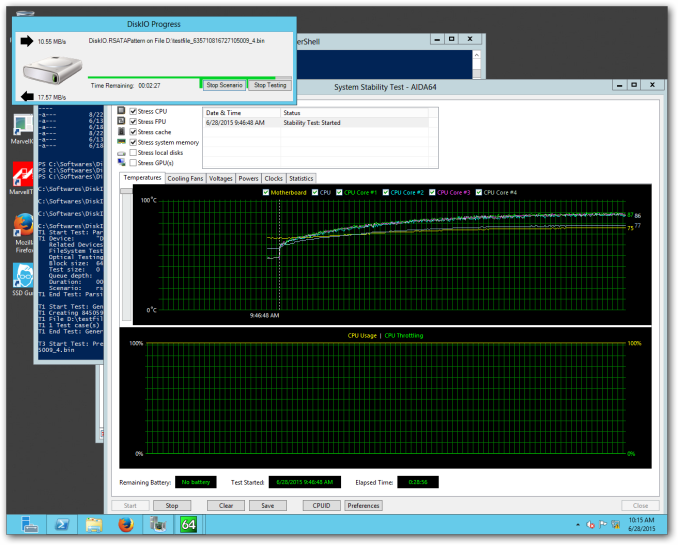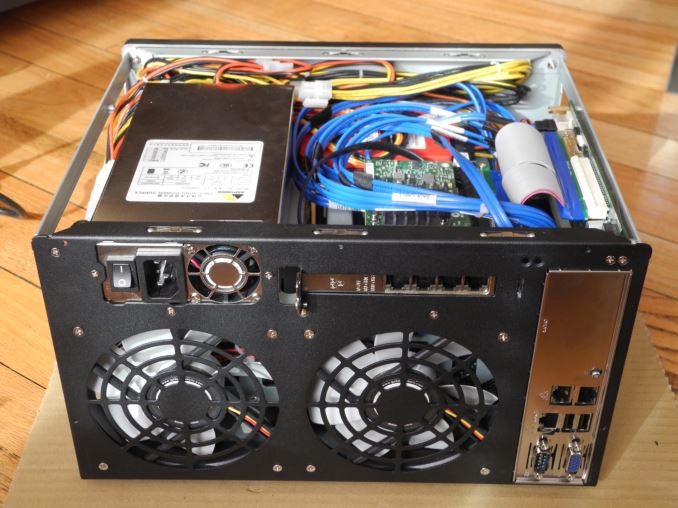ASRock Rack C2750D4I and U-NAS NSC-800: A DIY File Server
by Ganesh T S on August 10, 2015 8:45 AM EST- Posted in
- NAS
- storage server
- Avoton
- ASRock Rack
- U-NAS
Miscellaneous Aspects and Concluding Remarks
Low power consumption and the ability to keep the drives cool under stress are some of the desirable characteristics of file servers. In order to evaluate this aspect, we subject the system with Windows Storage Server 2012 R2 to a stability test using AIDA64. For stressing the disks (storage spaces volume using the drive bays), we used Microsoft's DiskIO with the pre-defined worst-case SATA patterns issued randomly with verification.
We find that the CPU doesn't throttle and the cores stabilize around 87 C, with the motherboard at 75 C. During this process, we also recorded power consumption at the wall. We found that the maximum power consumption was around 70 W, while the idling power consumption was around 38 W.
The ASRock Rack C2750D4I with the U-NAS NSC-800 is the first of three file servers that we have evaluated with Ubuntu 14.04 and Windows Storage Server 2012 R2. While the Phoronix Test Suite benchmarks have been chosen for their relevant to file server workloads, it appears that the SPEC SFS 2014 benchmarks do not bring out what people use the Storage Spaces feature for. We are still optimizing the testbed for SPEC SFS 2014, and we do have plans to evaluate other NAS OSes used in DIY builds using the same approach.
Coming to the business end of the review, we have two things to discuss. The ASRock Rack C2750D4I is almost the ideal motherboard for power users wanting to build a dedicated low-power file server or NAS. Native USB 3.0 support would have been nice, but a add-on card solution is not a bad one for those desiring high-speed external I/O. Other than that, there is not much to complain - The layout of the motherboard's SATA ports ensure that most of the disks can talk at full speed to the Avoton SoC. This becomes an issue only if one decides to take maximum advantage by utilizing all the SATA ports on the board. However, in our evaluation scenario, as the platform for a 8-bay file server, it fit in perfectly.
This brings us to the second aspect - the 8-bay U-NAS NSC-800. There are plenty of storage-focused chassis designs to choose from. In fact, the Silverstone DS380 is an excellent choice for those looking to install the motherboard in a flexible system. On the other hand, the NSC-800 brings in the compactness factor into the equation. Simply put, it is not possible to get a 8-bay NAS chassis smaller than the NSC-800. Any smaller, and a mini-ITX board with a single-slot PCIe card is not going to fit in. Even though U-NAS tries its best to make cabling easier by providing the SATA cables in a bundle from the backplane, installing the motherboard in such a cramped space is definitely a challenge.
The build presented in this review has a diskless cost of around USD 845 - a completely reasonable number given that the unit contains 8GB of ECC RAM. A look at the prices of commercial off-the-shelf diskless file servers based on Avoton make the DIY approach very attractive.












48 Comments
View All Comments
xicaque - Monday, November 23, 2015 - link
Can you elaborate on redundant power supplies? Please? What is their purpose?nxsfan - Tuesday, August 11, 2015 - link
I have the ASRack C2750d4i + Silverstone DS380, with 8x3.5" HDDs and one SSD (& 16GB ECC). Your CPU and MB temps seem high, particularly when (if I understand correctly) you populated the U-NAS with SSDs.If lm-sensors is correct my CPU cores idle around 25 C and under peak load get to 50 C. My MB sits around 41 C. My HDDs range from ~50 C (TOSHIBA MD04ACA500) to ~37 C (WDC WD40EFRX). "Peak" (logged in the last month) power consumption (obtained from the UPS - so includes a 24 port switch) was 60 W. Idle is 41 W.
The hardware itself is great. I virtualize with KVM and the hardware handles multiple VMs plus multiple realtime 1080p H.264 transcodes with aplomb (VC-1 not so much). File transfers saturate my gigabit network, but I am not a power user (i.e. typically only 2-3 active clients).
bill.rookard - Tuesday, August 11, 2015 - link
I really like this unit. Compact. Flexible. Well thought out. Best of all, -affordable-. Putting together a budget media server just became much easier. Now to just find a good itx based mobo with enough SATA ports to handle the 8 bays...KateH - Tuesday, August 11, 2015 - link
Another good turnkey solution from ASRock, but I still think they missed a golden opportunity by not making an "ASRack" brand for their NAS units ;)e1jones - Wednesday, August 12, 2015 - link
Would be great for a Xeon D-15*0 board, but most of the ones I've seen so far only have 6 sata ports. A little more horsepower to virtualize and run CPU intensive programs.akula2 - Monday, August 17, 2015 - link
>A file server can be used for multiple purposes, unlike a dedicated NAS.Well, I paused reading right there! What does that mean? You should improve on that sentence; it could be quite confusing to novice members who aspire to buy/build storage systems.
Next, I don't use Windows on any Servers. I never recommend that OS to anyone either, especially when the data is sensitive be it from business or personal perspective.
I use couple of NAS Servers based on OpenIndiana (Solaris based) and BSD OSes. ZFS can be great if one understands its design goals and philosophy.
I don't use FreeNAS or NAS boxes such as from Synology et al. I build the Hardware from the scratch to have greater choice and cost saving factors. Currently, I'm in Alpha stage building a large NAS Server (200+ TB) based on ZoL (ZFS on Linux). It will take at least two more months of effort to integrate to my company networks; few hundreds of associates based in three nations work more closely to augment efficiency and productivity.
Yeah, few more things to share:
1) Whatever I plan I look at Power consumption factor (green), especially high gulping ones such as Servers, Workstations, Hydrib Cluster, NAS Server etc. Hence, I allocate more funds to address the Power demand by deploying Solar solutions wherever it is viable in order to save some good money in the long run.
2) I mostly go for Hitachi SAS drives and SATA III about 20% (Enterprise segment).
3) ECC memory is mandatory. No compromise on this one to save some dough.
4) Moved away from Cloud service providers by building by private cloud (NAS based) to protect my employee privacy. All employee data should remain in the respective nations. Period.
GuizmoPhil - Friday, August 21, 2015 - link
I built a new server using their 4 bay model (NSC-400) last year. extremely sastisfied.Here's the pictures: https://picasaweb.google.com/117887570503925809876...
Below the specs:
CPU: Intel Core i3-4130T
CPU cooler: Thermolab ITX30 (not shown on the pictures, was upgraded after)
MOBO: ASUS H87i-PLUS
RAM: Crucial Ballistix Tactical Low Profile 1.35V XMP 8-8-8-24 (1x4GB)
SSD: Intel 320 series 80GB SATA 2.5"
HDD: 4x HGST 4TB CoolSpin 3.5"
FAN: Gelid 120mm sleeve silent fan (came with the unit)
PSU: Seasonic SS-350M1U
CASE: U-NAS NSC-400
OS: LinuxMint 17.1 x64 (basically ubuntu 14.04 lts, but hassle-free)
Iozone_guy - Wednesday, September 2, 2015 - link
I'm struggling to understand the test configuration. There seems to be a disconnect in the results. Almost all of the results have an average latency that is looking like a physical spindle, but yet the storage is all SSDs. How can the latency be so high ? Was there some problem with the setup, such that it wasn't measuring the SSD storage but something else ? Could the tester post the sfs_rc file and the sfslog.* and sfsc*.log files ? So we can try to sort out what happened ?